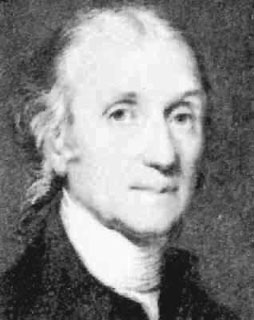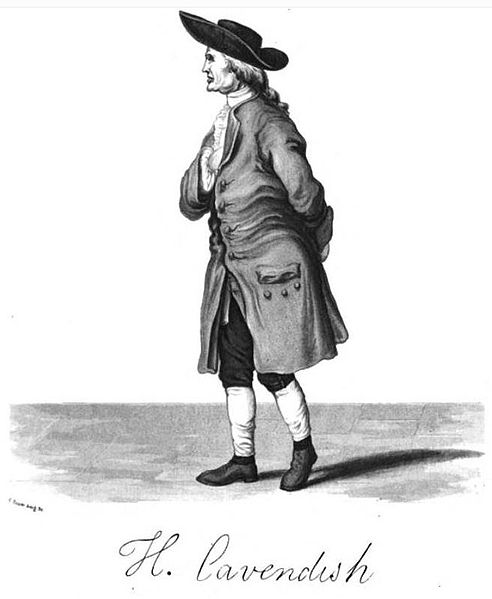<Back to Index>
- Chemist Henry Cavendish, 1731
- Composer Giuseppe Fortunino Francesco Verdi, 1813
- President of the South African Republic Stephanus Johannes Paulus Kruger, 1825


Henry Cavendish FRS (10 October 1731 – 24 February 1810) was a British scientist noted for his discovery of hydrogen or what he called "inflammable air". He described the density of inflammable air, which formed water on combustion, in a 1766 paper "On Factitious Airs". Antoine Lavoisier later reproduced Cavendish's experiment and gave the element its name. Cavendish is also known for the Cavendish experiment, his measurement of the Earth's density, and early research into electricity.
Henry Cavendish was born on 10 October 1731 in Nice, France, where his family was living at the time. His mother was Lady Anne Grey, daughter of the Duke of Kent, and his father was Lord Charles Cavendish, son of 2nd Duke of Devonshire. The family traces its lineage across eight centuries to Norman times and was closely connected to many aristocratic families of Great Britain. At age 11, Cavendish was a pupil at Peter Newcome's School in Hackney. At age 18 (on 24 November 1749) he entered the University of Cambridge in St Peter's College, now known as Peterhouse, but left four years later on 23 February 1753 without graduating. His first paper, "Factitious Airs", appeared thirteen years later, in 1766.
Cavendish was silent and solitary, and was viewed as somewhat eccentric by many. He only spoke to his female servants by notes and formed no close personal relationships outside his family. By one account, Cavendish had a back staircase added to his house in order to avoid encountering his housekeeper because he was especially shy of women. The contemporary accounts of his personality have led some modern commentators, such as Oliver Sacks, to speculate that he had Asperger syndrome, though he may merely have been painfully shy. His only social outlet was the Royal Society Club, whose members dined together before weekly meetings. Cavendish seldom missed these meetings, and was profoundly respected by his contemporaries. However his shyness made those who "sought his views... speak as if into vacancy. If their remarks were...worthy, they might receive a mumbled reply." He also enjoyed collecting fine furniture exemplified by his purchase of a set of "ten inlaid satinwood chairs with matching cabriole legged sofa" documented to have been acquired by Cavendish himself.
Because of his asocial and secretive behaviour, Cavendish often avoided publishing his work, and much of his findings were not even told to his fellow scientists. In the late nineteenth century, long after his death, James Clerk Maxwell looked through Cavendish's papers and found things for which others had been given credit. Examples of what was included in Cavendish's discoveries or anticipations were Richter's Law of Reciprocal Proportions, Ohm's Law, Dalton's Law of Partial Pressures, principles of electrical conductivity (including Coulomb's Law), and Charles's Law of Gases.
Cavendish
died in 1810 (as one of the wealthiest men in Britain) and was buried,
along with many of his ancestors, in the church that is now Derby Cathedral (and the road he used to live on in Derby has been named after him). The University of Cambridge's Cavendish Laboratory was endowed by one of Cavendish's later relatives, William Cavendish, 7th Duke of Devonshire (Chancellor of the University from 1861 to 1891). Cavendish is considered to be one of the so-called pneumatic chemists of the eighteenth and nineteenth centuries, along with, for example, Joseph Priestley, Joseph Black, and Daniel Rutherford. By combining metals with strong acids, Cavendish made hydrogen (H2) gas, which he isolated and studied. Although others, such as Robert Boyle, had prepared hydrogen gas earlier, Cavendish is usually given the credit for recognizing its elemental nature. Cavendish
observed that hydrogen, which he called "inflammable air", reacts with
oxygen, then known as "dephlogisticated air", to form water. James Watt and Antoine Lavoisier made a similar observation, resulting in a controversy as to who should receive credit for it. Cavendish
also accurately determined the composition of Earth's atmosphere. In a
1785 paper, he described experiments in which hydrogen and ordinary air
were combined in known ratios, and then exploded with a spark of
electricity. In each case, Cavendish observed both the formation of
water and that the gas volume after the explosion was always less than
it was before it. By careful measurements he was led to conclude that,
"common air consists of one part of dephlogisticated air [oxygen],
mixed with four of phlogisticated [nitrogen]". The
same paper described an experiment in which Cavendish was able to
remove, in modern terminology, both the oxygen and nitrogen gases from
a sample of atmospheric air until only a small bubble of unreacted gas
was left in the original sample. From this experiment Cavendish
concluded that not more than 1/120 of the Earth's atmosphere was other than oxygen and nitrogen. Although a seemingly small fraction, about 100 years later William Ramsay and Lord Rayleigh showed that this residual gas contained argon, an element that was unknown at the time. In addition to his achievements in chemistry, Cavendish is also known for the Cavendish experiment, the first to measure the force of gravity between
masses in a laboratory and to produce an accurate value for Earth's
density. His work led others to accurate values for the gravitational constant (G) and Earth's mass. Based on his results, one can calculate a value for G of 6.754 × 10−11N-m2/kg2, which compares favourably with the modern value of 6.67428 × 10−11N-m2/kg2. The equipment Cavendish used was designed and built by geologist John Michell,
who died before he could begin the experiment. The apparatus was sent
in crates to Cavendish, who completed the experiment in 1797 – 1798, and published the results. Cavendish
noticed that Michell's apparatus would be sensitive to temperature
differences and induced air currents so he made modifications by
isolating the apparatus in a separate room with external controls and
telescopes for making observations. The experimental apparatus consisted of a torsion balance to measure the gravitational attraction between two 350-pound lead spheres and a pair of 2-inch 1.61-pound lead spheres. Using this equipment, Cavendish found that the Earth's average density is 5.48 times greater than that of water. John Henry Poynting later noted that the data should have led to a value of 5.448, and indeed that is the average value of the twenty-nine determinations Cavendish included in his paper. It is not unusual to find books that erroneously describe Cavendish's work as a measurement either of the gravitational constant (G) or the Earth's mass, and this mistake has been pointed out by several authors. In reality, Cavendish's stated goal was to measure the Earth's density, and his result was later used to calculate G. The first time that this constant was used was in 1873, almost 100 years after the Cavendish experiment. Cavendish's results also can be used to calculate the Earth’s mass. Cavendish
performed his experiment in an outbuilding in the garden of his Clapham
Commons estate. For years afterward, his neighbours would point out the
building and tell their children that it was where the world was
weighed. Cavendish wrote papers on electrical topics for the Royal Society but the bulk of his electrical experiments did not become known until they were collected and published by James Clerk Maxwell a
century later, in 1879, long after other scientists had been credited
with the same results. Among Cavendish's discoveries were the following: